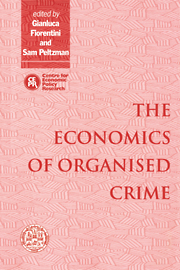Book contents
- Frontmatter
- Contents
- List of figures
- List of tables
- Foreword
- Acknowledgements
- List of conference participants
- 1 Introduction
- PART I THEORIES OF THE STATE AND THE ORIGIN OF CRIMINAL ORGANISATIONS
- PART II THE CRIMINAL ORGANISATION AS A FIRM
- 4 Internal cohesion and competition among criminal organisations
- Discussion
- 5 Conspiracy among the many: the mafia in legitimate industries
- Discussion
- PART III ORGANISED CRIME AND STATE INTERVENTION IN THE ECONOMY
- PART IV DETERRENCE POLICIES AGAINST LEGAL FIRMS INVOLVED IN ILLEGAL ACTIVITIES
- PART V DETERRENCE POLICIES AGAINST ORGANISED CRIME
- Index
4 - Internal cohesion and competition among criminal organisations
Published online by Cambridge University Press: 04 August 2010
- Frontmatter
- Contents
- List of figures
- List of tables
- Foreword
- Acknowledgements
- List of conference participants
- 1 Introduction
- PART I THEORIES OF THE STATE AND THE ORIGIN OF CRIMINAL ORGANISATIONS
- PART II THE CRIMINAL ORGANISATION AS A FIRM
- 4 Internal cohesion and competition among criminal organisations
- Discussion
- 5 Conspiracy among the many: the mafia in legitimate industries
- Discussion
- PART III ORGANISED CRIME AND STATE INTERVENTION IN THE ECONOMY
- PART IV DETERRENCE POLICIES AGAINST LEGAL FIRMS INVOLVED IN ILLEGAL ACTIVITIES
- PART V DETERRENCE POLICIES AGAINST ORGANISED CRIME
- Index
Summary
Introduction
Economic research on illegal activities has probably a limited importance in the literature if compared with the relevance of this phenomenon in many modern societies. This discrepancy is perhaps even more pronounced when we consider the economic analysis of criminal organisations.
The aim of this paper is to study some issues related to the internal organisation of illegal groups and to the interaction between competition and rivalry among criminal organisations and their internal structure. We adopt a very simple definition of an illegal organisation as one that cannot rely on the external enforcement of the judicial institutions and whose behaviour and possibilities are not constrained by the law.
In this setting the emergence of a set of individuals with stable and longterm relations and a hierarchical structure, i.e. an organisation, is far from being a simple task. The promoter of this group, the principal, has to hire agents to carry out the tasks required by an illegal activity. It is very reasonable to imagine that an agent, through his relation with the principal, acquires new resources that he can use for his own private benefit. A member of the criminal organisation, for instance, can appropriate goods or money of the family, or can use for his own sake information and know-how acquired during his illegal activity within the organisation.
To a certain extent, this behaviour is not specific to organisations that operate in illegal markets, and can be found even if a third party can enforce the contracts.
- Type
- Chapter
- Information
- The Economics of Organised Crime , pp. 87 - 108Publisher: Cambridge University PressPrint publication year: 1996
- 10
- Cited by



